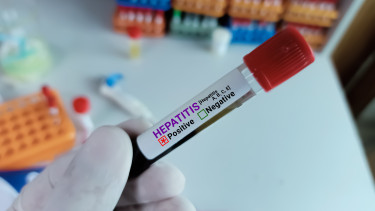Latest Hungarian epidemiological data suggest a temporary relief between coughing fits

The National Public Health Centre (NNK) was supposed to publish influenza statistics for the 51st week of 2023 on 28 December, but skipped it for a reason unbeknownst to us. Sticking to the publication schedule is not necessarily a forte of local authorities, so we assumed that this Thursday, the NNK will release figures both for the 51st and 52nd week. We were wrong. Anyway...
Key findings
- The number of samples tested remains low, even dropped from the 50th week, but is still three times higher than a year ago.
- The coronavirus positivity rate has remained largely unchanged (close to 41%), with 69% of patients hospitalised with severe acute respiratory infection (SARI) treated with SARS-CoV-2 infection.
- For the third consecutive week in the current flu season, a few people infected by influenza and respiratory syncytial virus (RSV) also needed hospital care.
- The number of people hospitalised with SARI and those in intensive care dropped by a third from a week ago.
The calm before the storm
The flu season generally peaks between the 7th and 10th week of the year, but the highest figures can vary greatly from one year to another. The coronavirus pandemic, for instance, put a serious dent into the spread of the flu (see graph below).
The start of this year's flu season looks dramatic on this particular chart, and we have no reason to believe that the epidemiological curve will magically flatten out.
We have already projected a dip for the holiday season, and the figures for the 52nd week will likely show further moderation. Come Christmas, people customarily go and shower their beloved relatives with gifts and viruses rather than going to the doctor, hence fewer infections to report. It's just a runny nose and a wee cough after all, yeah?

This time we give you a fuzzy-looking chart too, which shows data for a longer period, i.e. going back to the 2013/14 flu season. The red circle shows that we have no reason to be optimistic about what is coming.

On the 51st week, a total of 243,800 people sought medical help with severe acute respiratory infection (SARI), of whom 33,700 (13.8%) had flu-like symptoms. The former figure marks a 17.5% drop and the latter a 16.2% fall over the 50th week, which come come after increases of 12.6% and 29.5%, respectively.
The dip in the columns came on the back of two short weeks, with public holidays on 1 Nov and 23 Oct., when fewer people went to the doctor, and the autumn break in schools also helped in this respect. We'll likely have one more week showing moderation and then the epidemic curve will start its steep ascent.

The graph below allows a comparison with weeks 40 to 51 of 2022, showing higher figures for this year for both the number of SARI "patients" and particularly those that visited GPs with flu-like symptoms.

We can also compare the SARI and flu numbers for 100,000 inhabitants. Despite the temporary relief observed on the 51st week, this graph also suggests that the flu season will be more severe in 2023/24 than in 2022/23, or possibly worse than any time in the past decade or so.

We need to highlight that this year authorities perform way more tests than a year ago, even though the number of samples tested remains extremely low (290 in total on a national level last week, down from 327 a week earlier).

The number of samples tested on the 51st week was lower than on the 50th week, with the COVID-19 positivity rate down by a smidge. Testing is almost non-existent and we may draw only extremely cautious conclusions from these findings as regards the bigger picture on the current epidemiological situation. This is basically the only set of Covid data authorities provide besides weekly wastewater sampling results. Looking at the numbers, however, it's a pretty safe bet that SARS-CoV-2 remains the key pathogen for the time being.

As regards all samples tested up to the 50th week, the Covid positivity rate continues to stand out.

As authorities have been publishing separate SARI and flu statistics only since 2022, a longer-term comparison is possible only for the number of people seeking medical help with influenza-like symptoms. This is basically a magnification of the first ten weeks of the flu season depicted on very first graph above.

There were 243 people in hospital with SARI on the 51st week, versus 339 a week earlier. This marks a 32% drop. Over two thirds (69.1%) of them were treated with COVID-19, down from 72.9% a week earlier. Coronavirus was the main pathogen found in samples early in the flu season last year too. Actually, the first time the share of flu viruses in samples was higher than the share of SARS-CoV-2 occurred only at the start of this year in the 2022/23 flu season.
For the third consecutive week in this flu season, however, people tested positive for influenza virus and RSV also had to be hospitalised. The 47th week was the first one in this cold season when one of the samples showed influenza infection (up at 57 in total by the end of the 51st week). Other pathogens identified between the 40th and 51st week were SARS-CoV-2 (859), respiratory syncytial virus (RSV, 11), adenovirus (1), parainfluenza (4), human metapneumovirus (HMPV, 8), and rhinovirus (31).

113 (56.8%) of the 168 COVID-19 patients were aged 60 and over, which compares with 178 (60.2%) a week ago. The other two metrics, i.e. people in hospital with Covid, and 60+ Covid patients, show a decline from the previous week, -32% and -37%, respectively.

Almost 24% of those hospitalised with SARI were children aged 2 years or younger, while nearly 57% of them were aged 60 and over. The first figure marks an increase from 21.8%, the latter a drop from 60.2% a week ago. There was a decrease in the number of both groups (orange and green columns).

Another important indicator of the severity of an epidemic is how many of those hospitalised end up in the intensive care unit (or in the morgue for that matter). The NNK does not reveal mortality stats, though.
As mentioned above, there were 243 people with SARI in hospital on the week under review, down from 339 a week earlier. 31 of them were in the ICU, which corresponds to a 12.8% ratio, down from 46 (13.6%) a week earlier.

Finally, we have an age breakdown both for SARI and flu patients. Children up to the age of 14 are on top of the SARI age rankings in terms of numbers, while they are only on the 3rd spot in the flu rankings, behind those between 35 and 59 and the hardest-hit 15-34 age group. The right-hand charts show the share of people with SARI and flu-like symptoms by age group.
Looking back on the 2022/23 data we find that the 0-14 age group was the hardest hit throughout the flu season in terms of SARI, while in terms of flu-like symptoms they were the most affected age group between the 3rd and the 15th week of this year, i.e. from mid-January to mid-April.


Flu shots
We have asked for flu vaccination data from the NNK and received them for the past five cold seasons. A separate article will be published about COVID-19 and flu shots later on, but until then, here's the gist of the latter on a single graph. Note that these figures show only free-of-charge 3Fluart flu shots available for risk groups, i.e.
- people over 60 (regardless of health),
- people with chronic respiratory, cardiovascular or metabolic diseases,
- persons with reduced immunity,
- women who are pregnant or planning to have children.
The NNK said earlier that for this year's flu season, a total of 949,000 doses of 3Fluart vaccine are available those over 3 years of age, while 3,000 doses of Vaxigrip Tetra and 1,000 doses of Fluenz Tetra vaccine are soon be available for children under 3 years of age.

Cover photo: Getty Images









